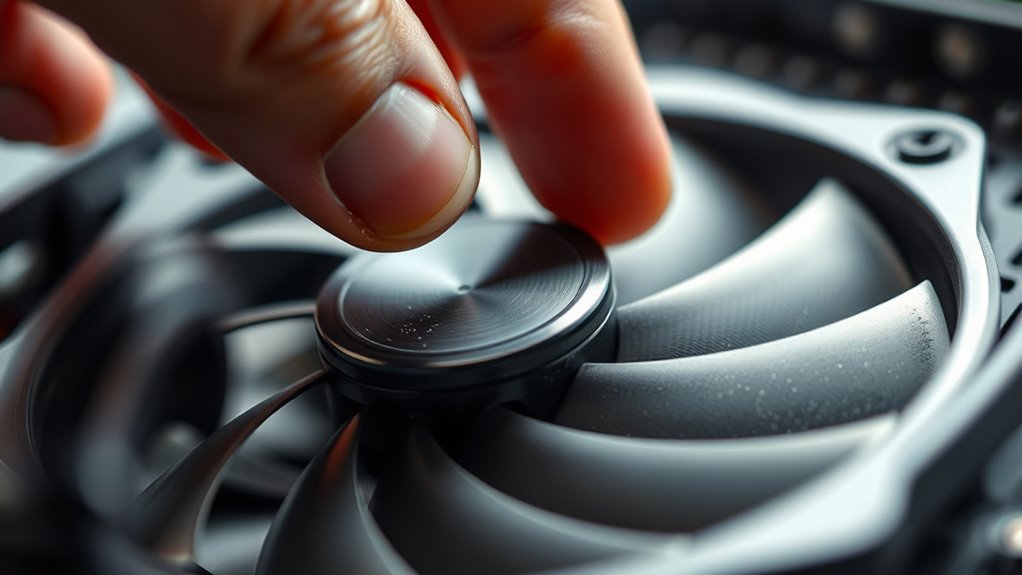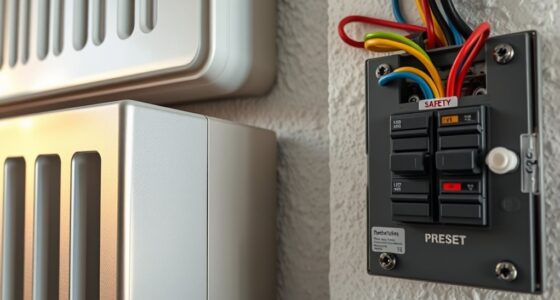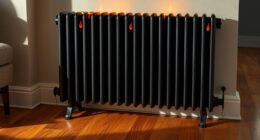Understanding fan noises involves recognizing different sounds caused by worn bearings, airflow obstructions, or imbalance. Using tools like vibration analysis and thermal imaging helps detect issues early before they worsen. Pay attention to subtle cues like faint grinding or irregular whirring, which warn of impending failure. Environmental factors like dust buildup and obstructions also impact noise levels. Mastering these techniques and clues can keep your fans quiet and reliable—continue exploring to uncover essential tips pros wish you knew.
Key Takeaways
- Combining vibration analysis and thermal imaging reveals hidden issues like misalignments and bearing failures early.
- Recognizing subtle audio cues, such as faint grinding or irregular whirring, helps diagnose developing component wear.
- Environmental factors like dust buildup and obstructions significantly impact noise levels and fan efficiency.
- Differentiating noise types—grinding, squealing, rattling—directs precise troubleshooting efforts.
- Regular preventative maintenance, including cleaning and using quieter fan models, reduces noise and extends component lifespan.
Recognizing Different Types of Fan Noises and Their Causes
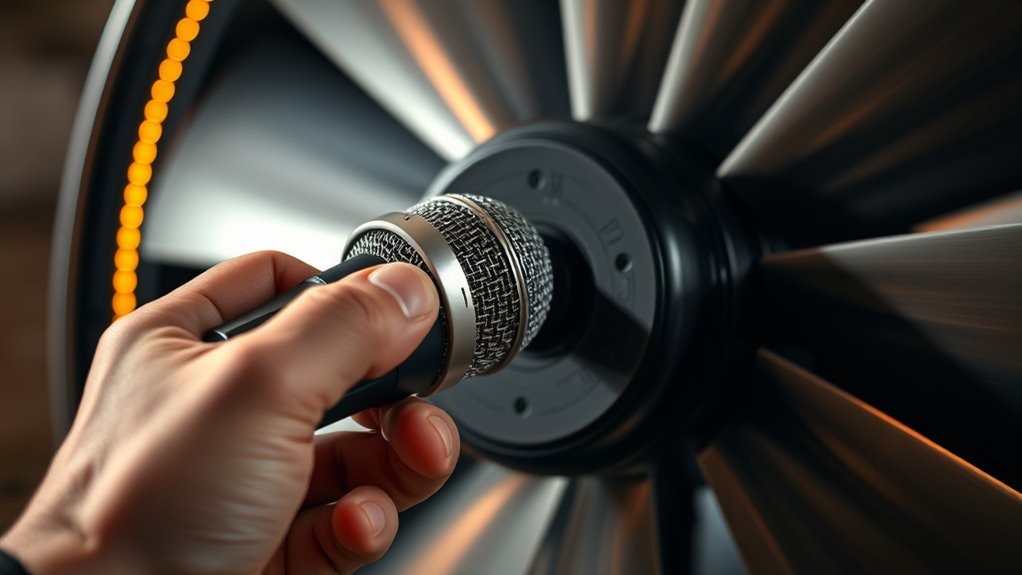
How can you tell what’s causing a fan to make strange noises? Start by listening closely. If the sound is grinding or squeaking, it’s often due to bearing wear, which causes increased friction and noise. A high-pitched whine may indicate a loose or damaged bearing, or imbalance. On the other hand, airflow obstructions can produce rattling or buzzing sounds. Check for debris, dust buildup, or objects blocking the blades. These obstructions disrupt smooth airflow, creating abnormal noises. Recognizing these signs helps you pinpoint the cause quickly. Bearings deteriorate over time, and airflow obstructions can happen suddenly or gradually. By paying attention to the type of noise and its source, you’re better equipped to diagnose and address the problem efficiently. Additionally, understanding fan maintenance can help prevent future issues and prolong the lifespan of your fan.
Tools and Techniques for Accurate Fan Noise Diagnosis
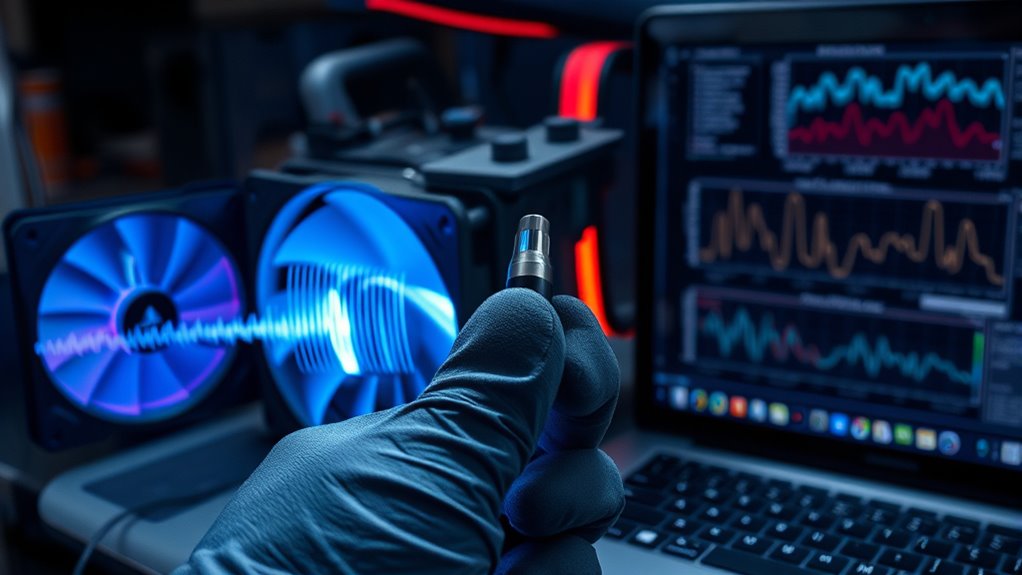
To accurately diagnose fan noises, you need the right tools and techniques that help pinpoint issues quickly. Vibration analysis is essential; it detects imbalances or misalignments by measuring vibration patterns, revealing hidden faults before they worsen. Thermal imaging is another powerful technique, allowing you to visualize heat buildup caused by bearing failures or excessive friction. By scanning the fan and surrounding components, thermal cameras highlight hotspots that indicate failing parts. These tools provide immediate, visual feedback, enabling precise identification of the noise source without invasive procedures. Combining vibration analysis with thermal imaging gives you an extensive view of mechanical health, helping you troubleshoot effectively. Mastering these techniques ensures faster diagnosis, reduced downtime, and more reliable fan operation. Additionally, understanding the trustworthiness of AI models can assist in developing smarter diagnostic tools that adapt to evolving fan system issues.
Interpreting Subtle Audio Cues to Identify Failing Components
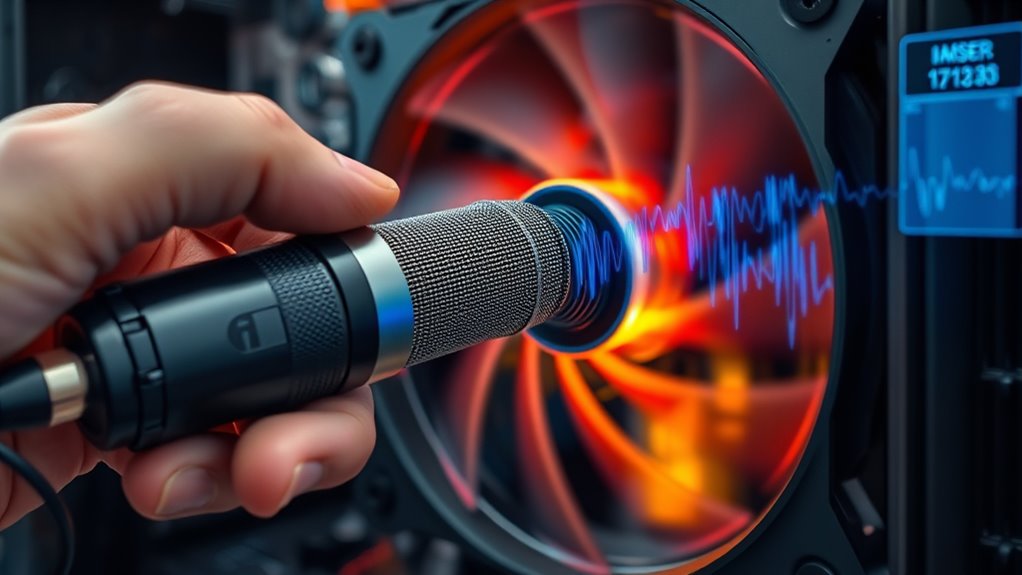
Interpreting subtle audio cues requires careful attention to the unique sounds a fan produces as it begins to fail. Small changes in noise, like faint grinding or irregular whirring, often indicate bearing wear. When bearings deteriorate, you might hear a persistent, high-pitched squeal or a rough, uneven tone during operation. Airflow imbalance can also cause subtle sounds, such as fluctuating pitch or intermittent rattling, signaling that blades are hitting obstructions or that airflow is uneven. These cues are easy to overlook but are essential for early diagnosis. By listening closely, you can identify these nuanced sounds and pinpoint the failing component before it worsens, saving time and preventing more extensive damage. Paying attention to headphone audio cues can also help diagnose issues in other electronic devices by revealing subtle operational anomalies.
Environmental Factors That Affect Fan Performance and Noise Levels
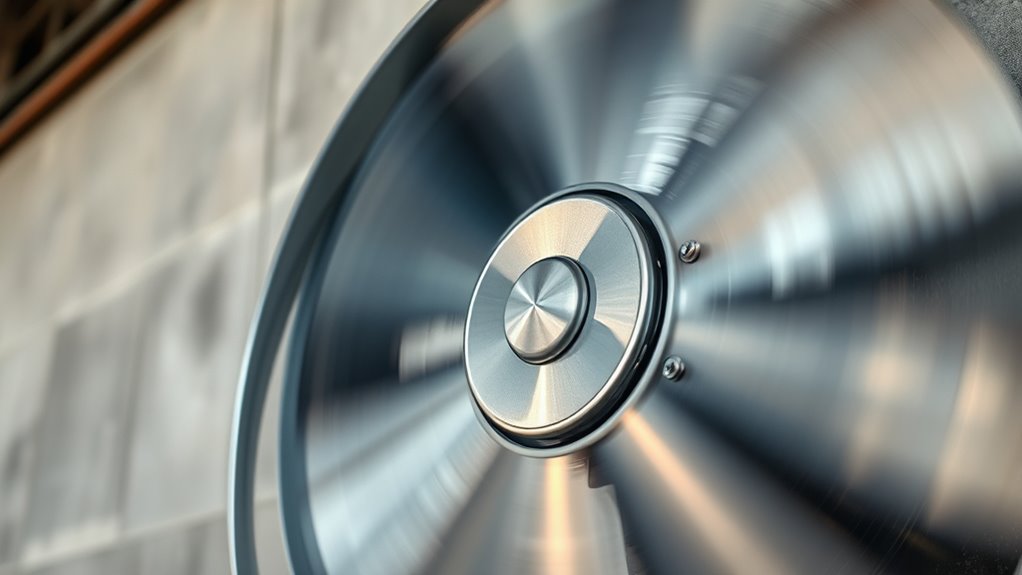
Environmental factors play a significant role in influencing fan performance and noise levels. Dust buildup inside the fan or on its blades can cause imbalance, leading to increased vibrations and noise. It also hampers heat dissipation, forcing the fan to work harder. Airflow obstructions, such as cables, dust, or debris blocking vents, create resistance that forces the fan to spin faster, amplifying noise. Poor ventilation environments can cause fans to operate at higher speeds constantly, raising wear and sound levels. Regularly inspecting for dust buildup and clearing airflow obstructions can help maintain ideal performance. Recognizing how these environmental factors impact your fan’s noise and efficiency enables you to diagnose issues more accurately and prevent unnecessary wear or failure down the line. Additionally, understanding the importance of lifestyle elements, such as workspace organization and ambient conditions, can further optimize fan performance and reduce noise disturbances.
Preventative Measures and Best Practices for Quiet, Reliable Cooling

Implementing regular maintenance is essential for keeping your cooling system quiet and reliable. Start by optimizing fan speed; adjust settings to match workload, reducing unnecessary noise and wear. Proper airflow management is also vital—ensure vents and filters are clean and unobstructed to prevent overheating and excessive fan activity. Use quality components and consider upgrading to quieter fans with better bearings or noise-dampening features. Keep your system free of dust, which can cause fans to work harder and generate more noise. Regularly inspecting and cleaning your cooling setup maintains efficiency, minimizes vibrations, and avoids sudden failures. By focusing on fan speed optimization and airflow management, you’ll enhance system longevity, reduce noise levels, and enjoy a more stable, quiet operation. Incorporating sound dampening materials can further help in reducing operational noise and creating a quieter environment.
Frequently Asked Questions
How Can I Differentiate Between Normal and Abnormal Fan Noise?
You can differentiate normal from abnormal fan noise by listening closely to the sound. Normal noise is steady and smooth, while abnormal noise often includes rattling, grinding, or squealing. If you notice a fan blade wobbling or if the noise increases with bearing wear, it’s a sign something’s wrong. Regularly check for unusual vibrations or sounds, as these indicate potential issues needing attention before they worsen.
What Are the Signs of Impending Fan Failure Beyond Noise?
You notice subtle changes—bearing wear causes unusual vibrations, and odd vibration patterns hint at trouble ahead. These signs often appear before fan failure, like a ticking clock warning you to act. If you feel increased resistance or hear irregular noises combined with shifting vibration patterns, it’s a sign that the bearings are deteriorating. Stay alert; catching these early signs can prevent a sudden, costly breakdown.
Are There Specific Brands or Models More Prone to Noise Issues?
Some brands and models are more prone to noise issues due to their reputation and design. You’ll notice that budget brands often have lower-quality components, leading to louder operation or failure. Look for models with solid reviews on brand reputation, and consider those with a well-designed fan system. Brands like Noctua or Corsair tend to have quieter fans because of their focus on quality and advanced model design, reducing noise issues.
How Often Should I Perform Detailed Fan Noise Inspections?
You should perform detailed fan noise inspections during routine maintenance, ideally every 3 to 6 months. Regular checks help catch issues early, allowing you to implement noise mitigation strategies effectively. By staying proactive, you decrease the risk of prolonged noise problems and ensure your system runs smoothly. Consistent inspections also help identify worn bearings or debris, keeping your fans quiet and efficient longer.
Can Software Tools Accurately Measure Fan Noise Levels?
Listen, software tools aren’t quite the crystal ball for fan noise accuracy. They can measure noise levels effectively, but measurement limitations mean they might miss subtle sounds or vary with environmental factors. Think of it like relying on a first-generation smartphone—great for quick checks but not perfect. For precise diagnosis, use software as a guide, but don’t forget the importance of your ears and hands-on inspections to get the full picture.
Conclusion
By mastering fan noise diagnosis, you become a detective uncovering hidden issues that could cause chaos in your system. Recognize subtle sounds, use the right tools, and consider environmental factors to keep your cooling quiet and reliable. Think of yourself as a maestro conducting a symphony—every noise, hum, and whirr plays an essential role. With these skills, you’ll prevent minor glitches from turning into a technical disaster of epic proportions.
